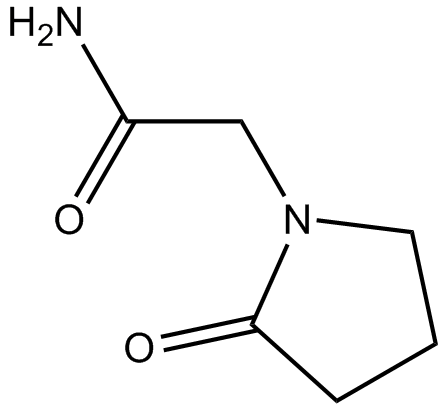Piracetam (Synonyms: UCB 6215) |
| Katalog-Nr.GC13469 |
Piracetam (UCB-6215) ist ein zyklisches Derivat des Neurotransmitters Gamma-AminobuttersÄure (GABA), das zur Behandlung einer Vielzahl von kognitiven StÖrungen eingesetzt wird.
Products are for research use only. Not for human use. We do not sell to patients.

Cas No.: 7491-74-9
Sample solution is provided at 25 µL, 10mM.
Piracetam (UCB-6215) is a cyclic derivative of the neurotransmitter gamma-aminobutyric acid (GABA), used in treatment of a wide range of cognitive disorders.
Piracetam (UCB-6215) is able to significantly decrease the fusogenic and destabilising effect of Abeta 29-42, in a concentration-dependent manner. Preincubation of piracetam, at a piracetam/peptide ratio of 960, during 20 min before the addition of Abeta 29-42 prevents almost completely the mixture of the two fluorescent probes. Preincubation of piracetam with lipids prevents almost completely the release of calcein induced by the peptide in a dose-dependent fashion (piracetam/peptide ratios from 9.6 to 960)[1].
Piracetam (UCB-6215) (< 1.0 mM) preincubated with brain membranes enhances membrane fluidity in aged mice, rats and humans, as indicated by decreased anisotropy of the membrane-bound fluorescence probe 1,6-diphenyl-1,3,5-hexatriene (DPH). Piracetam (UCB-6215) (300 mg/kg once daily) significantly increases membrane fluidity in some brain regions of young and aged rats, but has no measurable effect on membrane fluidity in the young rats[2]. Piracetam (UCB-6215) (300 mg/kg daily for 6 weeks) improves active avoidance learning in the aged rats only and elevates membrane fluidity in all brain regions except the cerebellum in the aged rats. Piracetam (UCB-6215) (300 mg/kg daily for 6 weeks) also improves NMDA receptor density in the hippocampus and on muscarinic cholinergic receptor densities in the frontal cortex and the striatum and to a lesser extent in the hippocampus of rats[3].
References:
[1]. Mingeot-Leclercq, M.P., et al., Piracetam inhibits the lipid-destabilising effect of the amyloid peptide Abeta C-terminal fragment. Biochim Biophys Acta, 2003. 1609(1): p. 28-38.
[2]. Muller, W.E., et al., Effects of piracetam on membrane fluidity in the aged mouse, rat, and human brain. Biochem Pharmacol, 1997. 53(2): p. 135-40.
[3]. Scheuer, K., et al., Piracetam improves cognitive performance by restoring neurochemical deficits of the aged rat brain. Pharmacopsychiatry, 1999. 32 Suppl 1: p. 10-6.
Average Rating: 5 (Based on Reviews and 40 reference(s) in Google Scholar.)
GLPBIO products are for RESEARCH USE ONLY. Please make sure your review or question is research based.
Required fields are marked with *




















